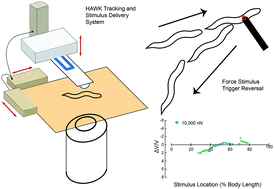当前位置:
X-MOL 学术
›
Integr. Biol.
›
论文详情
Our official English website, www.x-mol.net, welcomes your
feedback! (Note: you will need to create a separate account there.)
The tactile receptive fields of freely moving Caenorhabditis elegans nematodes
Integrative Biology ( IF 1.5 ) Pub Date : 2018-07-20 , DOI: 10.1039/c8ib00045j E A Mazzochette 1 , A L Nekimken 2 , F Loizeau 3 , J Whitworth 3 , B Huynh 3 , M B Goodman 2 , B L Pruitt 4
Integrative Biology ( IF 1.5 ) Pub Date : 2018-07-20 , DOI: 10.1039/c8ib00045j E A Mazzochette 1 , A L Nekimken 2 , F Loizeau 3 , J Whitworth 3 , B Huynh 3 , M B Goodman 2 , B L Pruitt 4
Affiliation

|
Sensory neurons embedded in skin are responsible for the sense of touch. In humans and other mammals, touch sensation depends on thousands of diverse somatosensory neurons. By contrast, Caenorhabditis elegans nematodes have six gentle touch receptor neurons linked to simple behaviors. The classical touch assay uses an eyebrow hair to stimulate freely moving C. elegans, evoking evasive behavioral responses. This assay has led to the discovery of genes required for touch sensation, but does not provide control over stimulus strength or position. Here, we present an integrated system for performing automated, quantitative touch assays that circumvents these limitations and incorporates automated measurements of behavioral responses. The Highly Automated Worm Kicker (HAWK) unites a microfabricated silicon force sensor holding a glass bead forming the contact surface and video analysis with real-time force and position control. Using this system, we stimulated animals along the anterior–posterior axis and compared responses in wild-type and spc-1(dn) transgenic animals, which have a touch defect due to expression of a dominant-negative α-spectrin protein fragment. As expected from prior studies, delivering large stimuli anterior and posterior to the mid-point of the body evoked a reversal and a speed-up, respectively. The probability of evoking a response of either kind depended on stimulus strength and location; once initiated, the magnitude and quality of both reversal and speed-up behavioral responses were uncorrelated with stimulus location, strength, or the absence or presence of the spc-1(dn) transgene. Wild-type animals failed to respond when the stimulus was applied near the mid-point. These results show that stimulus strength and location govern the activation of a characteristic motor program and that the C. elegans body surface consists of two receptive fields separated by a gap.
中文翻译:

自由移动的秀丽隐杆线虫的触觉感受野
嵌入皮肤的感觉神经元负责触觉。在人类和其他哺乳动物中,触觉取决于数千个不同的体感神经元。相比之下,秀丽隐杆线虫有六个与简单行为相关的温和触觉感受器神经元。经典的触摸测定使用眉毛刺激自由移动的秀丽隐杆线虫,引起逃避行为反应。该测定发现了触觉所需的基因,但不能提供对刺激强度或位置的控制。在这里,我们提出了一个用于执行自动化定量触摸测定的集成系统,该系统规避了这些限制并结合了行为反应的自动测量。高度自动化蠕虫踢球器 (HAWK) 将微型硅力传感器与形成接触面的玻璃珠结合在一起,并通过实时力和位置控制进行视频分析。使用该系统,我们沿着前后轴刺激动物,并比较野生型和spc-1(dn)转基因动物的反应,这些动物由于显性失活 α-血影蛋白片段的表达而具有触觉缺陷。正如之前研究所预期的那样,向身体中点前方和后方提供大刺激分别会引起逆转和加速。引起任何一种反应的概率取决于刺激强度和位置;一旦开始,逆转和加速行为反应的幅度和质量与刺激位置、强度或spc-1(dn)转基因的存在或不存在无关。当刺激施加到中点附近时,野生型动物没有反应。 这些结果表明,刺激强度和位置控制特征运动程序的激活,并且秀丽隐杆线虫体表由两个由间隙隔开的感受野组成。
更新日期:2018-07-20
中文翻译:

自由移动的秀丽隐杆线虫的触觉感受野
嵌入皮肤的感觉神经元负责触觉。在人类和其他哺乳动物中,触觉取决于数千个不同的体感神经元。相比之下,秀丽隐杆线虫有六个与简单行为相关的温和触觉感受器神经元。经典的触摸测定使用眉毛刺激自由移动的秀丽隐杆线虫,引起逃避行为反应。该测定发现了触觉所需的基因,但不能提供对刺激强度或位置的控制。在这里,我们提出了一个用于执行自动化定量触摸测定的集成系统,该系统规避了这些限制并结合了行为反应的自动测量。高度自动化蠕虫踢球器 (HAWK) 将微型硅力传感器与形成接触面的玻璃珠结合在一起,并通过实时力和位置控制进行视频分析。使用该系统,我们沿着前后轴刺激动物,并比较野生型和spc-1(dn)转基因动物的反应,这些动物由于显性失活 α-血影蛋白片段的表达而具有触觉缺陷。正如之前研究所预期的那样,向身体中点前方和后方提供大刺激分别会引起逆转和加速。引起任何一种反应的概率取决于刺激强度和位置;一旦开始,逆转和加速行为反应的幅度和质量与刺激位置、强度或spc-1(dn)转基因的存在或不存在无关。当刺激施加到中点附近时,野生型动物没有反应。 这些结果表明,刺激强度和位置控制特征运动程序的激活,并且秀丽隐杆线虫体表由两个由间隙隔开的感受野组成。











































 京公网安备 11010802027423号
京公网安备 11010802027423号